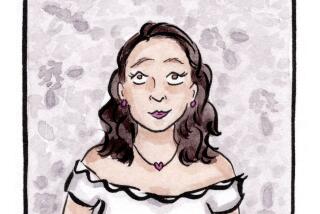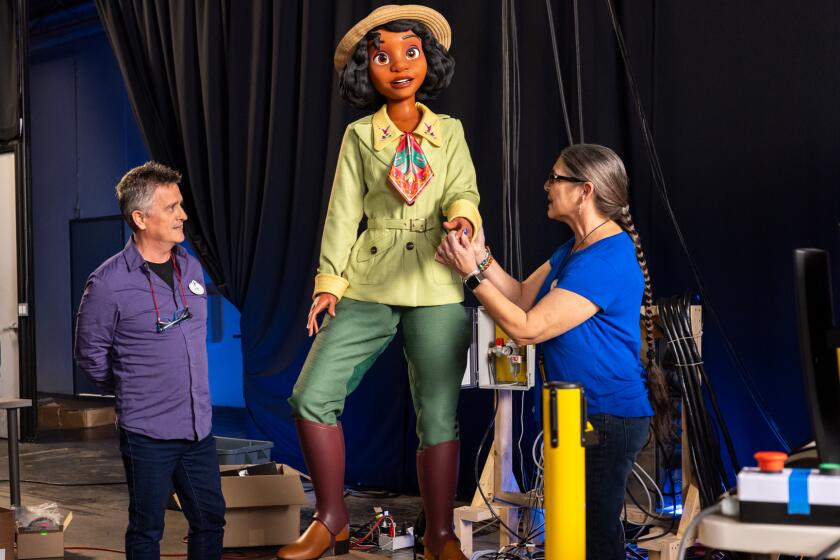In Hiromi Goto’s first graphic novel ‘Shadow Life,’ it’s one tough old woman against death
While Betty White may be dabbing her way to pop culture supremacy, it’s not often that we see older women’s stories highlighted in entertainment, even in comics.
Author Hiromi Goto agrees.
“We rarely see old women as the main characters of their own stories, especially in visual form,” says Goto. So she has set out to change that.
Goto, a Japanese Canadian writer whose previous works include “Chorus of Mushrooms,” “The Kappa Child” and “Half World,” is collaborating with artist Celine Loup for “Shadow Life,” her first graphic novel.
See more of Entertainment’s top stories on Facebook >>
“‘Shadow Life’ is a graphic novel about a 76-year-old Japanese Canadian woman whose well-meaning middle-aged daughters have placed in an assisted living complex,” says Goto. This woman, Kumiko, then “goes on the lam.”
“She sets herself up in a bachelor apartment where she enjoys daily small pleasures,” Goto explains. “[But] when Death’s shadow catches up with her, Kumiko’s sweet life begins to crumble. What can one old woman do to outwit Death? Kumiko’s in her final fight for the rest of her life.”
“Kumiko is the kind of person few people write stories about — elderly, chubby, queer and Asian — and as such I’m immediately drawn to her as a character,” says Loup. She hopes the book will appeal to “both longtime readers of comics and people who have never picked up a comic book but long to see someone a little more like themselves leading the stories they read.”
The graphic novel is slated for a 2018 release from First Second Books.
Goto discussed the details of “Shadow Life” over email.
What was your inspiration for Kumiko and her story?
I was raised by my maternal grandmother, my Oba-chan, so I’ve had a soft spot for tough old women my entire life. I don’t see enough popular culture images or narratives that center [around] old women as the hero of their own stories — I guess I’m writing toward what I’d like to see more of in contemporary literature; more [tough] old women living rich and complex lives.
When I was a child in the ‘70s I read a Japanese manga series by Machiko Hasegawa called “Ijiwaru Baa-san,” or “Granny Mischief” (English translation). It left a big impression upon me. The stories were in four panel columns, so very short arcs. But holy smokes, this old woman was mean! Deliciously, selfishly mean, unapologetic and outrageous. I loved it! Especially in the face of cultural norms and expectations, “Ijiwaru-Baa-san” was a breath of fresh air with a middle finger raised. That’s how I read it, anyway!
Why tell Kumiko’s story in a graphic novel?
Graphic novel as a narrative form was something I wanted to check out. I read some manga and American comics through my childhood, but returned to thinking about the form more seriously after reading “Barefoot Gen,” and “Maus.” Contemporary adult content graphic novels like [Alison] Bechdel’s “Fun Home” also showed me how much range and depth was possible. My daughter is also very manga oriented and has kept me abreast of the current trends coming out of Japan.
It’s a neat form of storytelling and I was curious as to how the very nature of representation would affect reader experience. And, also, I’m a writer who likes to explore new (to me) things … I wanted to give it a try.
What is the appeal of working in this medium? How different was it for you and your creative process to write the story as a graphic novel?
I don’t want to be a complete [jerk] … but writing the script for a graphic novel is/was faster than writing a novel. In a novel, the writer has to write everything in words. In graphic novels, the artist illustrates the story to convey in images what the words gestured toward. So as I writer, I literally have to write less than the word count required for a novel.
Of course you need a solid story, strong characters, suspense, mood, setting, cohesive and dramatic arc, all that stuff. But aside from dialogue it can be written in point form.
But no one should automatically think it’s easier. It was a faster process for me, yes. But maybe it was a fluke? Who knows?
I also love it that there’s a surprise factor in the outcomes of the completed book. I’m a very visual writer, I see the scenes in my head as I write them, as if they’re clips from a film, but I don’t know exactly how or what Celine Loup sees — obviously it will be not exactly what I’ve imagined because we have different brains. So the final book will be this amazing art surprise! Holy smokes!
On a craft note, I streamlined the writing of Kumiko’s story compared to what I would have done with her tale in a novel. In practical terms there’s not a huge amount of space for interiority in graphic novels, a trademark of literary fiction. I had to select scenes/moments based upon how well it renders visually, obviously. In many ways I approached the writing of the story as I would a screenplay (which I’ve never written before, either).
How did your collaboration with Celine Loup come about?
My awesome editor, Calista Brill, and I made a wish list of artists whom we loved/admired. I’m not so well-versed with who’s out there producing amazing art — so much of it is online now, which is fabulous! I was adamant that I wanted a female artist on board and Calista totally got that. Feelers were sent out and we came up with a shortlist. Calista had them send samples based on the manuscript. We both fell in love with Celine’s beautiful illustrative style. She captured the mood of it, the darkness of some of the scenes, the vitality of the old women. The stars had aligned.
Twitter: @tracycbrown
More to Read
The biggest entertainment stories
Get our big stories about Hollywood, film, television, music, arts, culture and more right in your inbox as soon as they publish.
You may occasionally receive promotional content from the Los Angeles Times.







